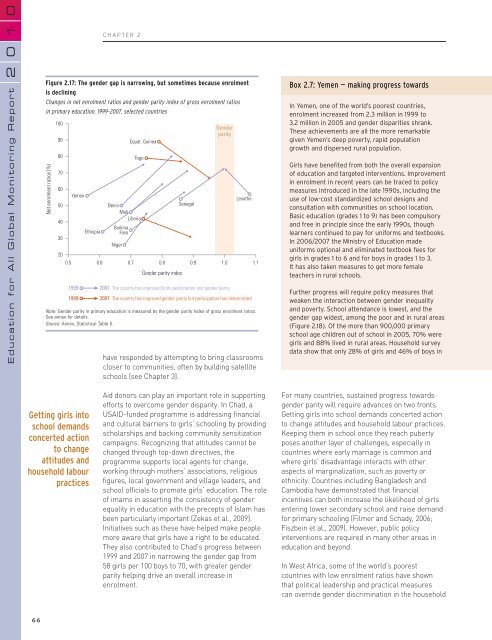Chapter 2. Progress towards the EFA goals - Unesco
Chapter 2. Progress towards the EFA goals - Unesco
Chapter 2. Progress towards the EFA goals - Unesco
You also want an ePaper? Increase the reach of your titles
YUMPU automatically turns print PDFs into web optimized ePapers that Google loves.
0<br />
0<br />
1<br />
CHAPTER 2<br />
2<br />
Education for All Global Monitoring Report<br />
Figure <strong>2.</strong>17: The gender gap is narrowing, but sometimes because enrolment<br />
is declining<br />
Changes in net enrolment ratios and gender parity index of gross enrolment ratios<br />
in primary education, 1999–2007, selected countries<br />
Net enrolment ratios (%)<br />
100<br />
90<br />
80<br />
70<br />
60<br />
50<br />
40<br />
30<br />
20<br />
Yemen<br />
Ethiopia<br />
Equat. Guinea<br />
Togo<br />
Lesotho<br />
0.5 0.6 0.7 0.8 0.9 1.0 1.1<br />
1999<br />
1999<br />
Benin<br />
Mali<br />
Liberia<br />
Burkina<br />
Faso<br />
Niger<br />
Gender parity index<br />
Senegal<br />
Gender<br />
parity<br />
2007 The country has improved both participation and gender parity<br />
2007 The country has improved gender parity but participation has deteriorated<br />
Note: Gender parity in primary education is measured by <strong>the</strong> gender parity index of gross enrolment ratios.<br />
See annex for details.<br />
Source: Annex, Statistical Table 5.<br />
have responded by attempting to bring classrooms<br />
closer to communities, often by building satellite<br />
schools (see <strong>Chapter</strong> 3).<br />
Box <strong>2.</strong>7: Yemen — making progress <strong>towards</strong><br />
In Yemen, one of <strong>the</strong> world’s poorest countries,<br />
enrolment increased from <strong>2.</strong>3 million in 1999 to<br />
3.2 million in 2005 and gender disparities shrank.<br />
These achievements are all <strong>the</strong> more remarkable<br />
given Yemen’s deep poverty, rapid population<br />
growth and dispersed rural population.<br />
Girls have benefited from both <strong>the</strong> overall expansion<br />
of education and targeted interventions. Improvement<br />
in enrolment in recent years can be traced to policy<br />
measures introduced in <strong>the</strong> late 1990s, including <strong>the</strong><br />
use of low-cost standardized school designs and<br />
consultation with communities on school location.<br />
Basic education (grades 1 to 9) has been compulsory<br />
and free in principle since <strong>the</strong> early 1990s, though<br />
learners continued to pay for uniforms and textbooks.<br />
In 2006/2007 <strong>the</strong> Ministry of Education made<br />
uniforms optional and eliminated textbook fees for<br />
girls in grades 1 to 6 and for boys in grades 1 to 3.<br />
It has also taken measures to get more female<br />
teachers in rural schools.<br />
Fur<strong>the</strong>r progress will require policy measures that<br />
weaken <strong>the</strong> interaction between gender inequality<br />
and poverty. School attendance is lowest, and <strong>the</strong><br />
gender gap widest, among <strong>the</strong> poor and in rural areas<br />
(Figure <strong>2.</strong>18). Of <strong>the</strong> more than 900,000 primary<br />
school age children out of school in 2005, 70% were<br />
girls and 88% lived in rural areas. Household survey<br />
data show that only 28% of girls and 46% of boys in<br />
Getting girls into<br />
school demands<br />
concerted action<br />
to change<br />
attitudes and<br />
household labour<br />
practices<br />
Aid donors can play an important role in supporting<br />
efforts to overcome gender disparity. In Chad, a<br />
USAID-funded programme is addressing financial<br />
and cultural barriers to girls’ schooling by providing<br />
scholarships and backing community sensitization<br />
campaigns. Recognizing that attitudes cannot be<br />
changed through top-down directives, <strong>the</strong><br />
programme supports local agents for change,<br />
working through mo<strong>the</strong>rs’ associations, religious<br />
figures, local government and village leaders, and<br />
school officials to promote girls’ education. The role<br />
of imams in asserting <strong>the</strong> consistency of gender<br />
equality in education with <strong>the</strong> precepts of Islam has<br />
been particularly important (Zekas et al., 2009).<br />
Initiatives such as <strong>the</strong>se have helped make people<br />
more aware that girls have a right to be educated.<br />
They also contributed to Chad’s progress between<br />
1999 and 2007 in narrowing <strong>the</strong> gender gap from<br />
58 girls per 100 boys to 70, with greater gender<br />
parity helping drive an overall increase in<br />
enrolment.<br />
For many countries, sustained progress <strong>towards</strong><br />
gender parity will require advances on two fronts.<br />
Getting girls into school demands concerted action<br />
to change attitudes and household labour practices.<br />
Keeping <strong>the</strong>m in school once <strong>the</strong>y reach puberty<br />
poses ano<strong>the</strong>r layer of challenges, especially in<br />
countries where early marriage is common and<br />
where girls’ disadvantage interacts with o<strong>the</strong>r<br />
aspects of marginalization, such as poverty or<br />
ethnicity. Countries including Bangladesh and<br />
Cambodia have demonstrated that financial<br />
incentives can both increase <strong>the</strong> likelihood of girls<br />
entering lower secondary school and raise demand<br />
for primary schooling (Filmer and Schady, 2006;<br />
Fiszbein et al., 2009). However, public policy<br />
interventions are required in many o<strong>the</strong>r areas in<br />
education and beyond.<br />
In West Africa, some of <strong>the</strong> world’s poorest<br />
countries with low enrolment ratios have shown<br />
that political leadership and practical measures<br />
can override gender discrimination in <strong>the</strong> household<br />
66
















